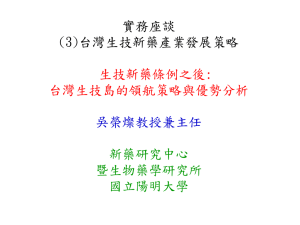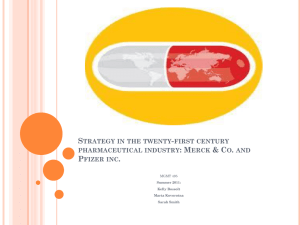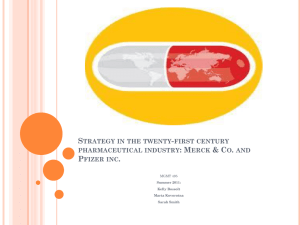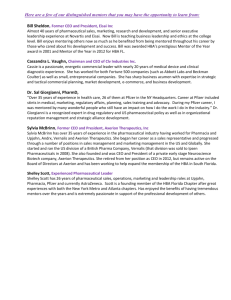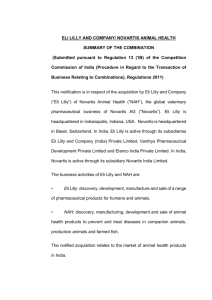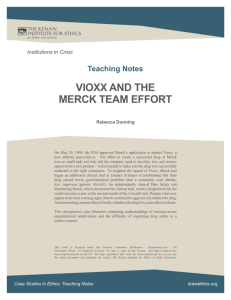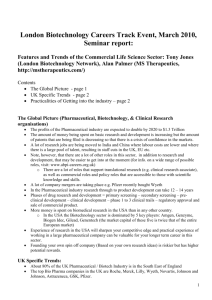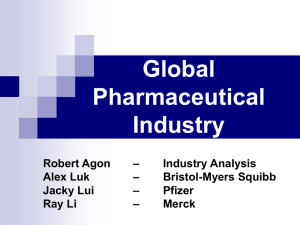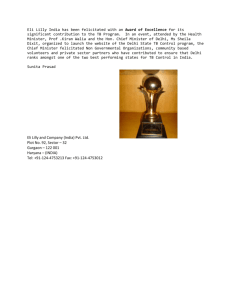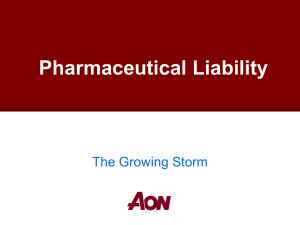Past three months
advertisement
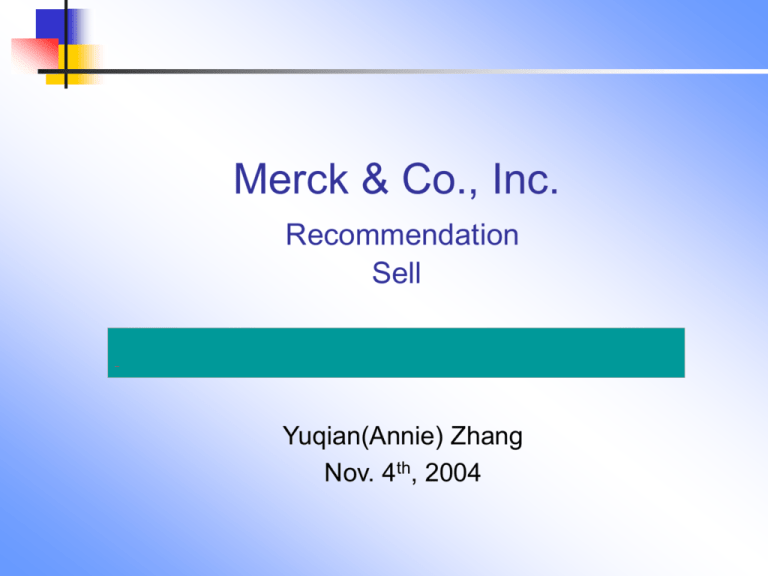
Merck & Co., Inc. Recommendation Sell Yuqian(Annie) Zhang Nov. 4th, 2004 Our position Own 300 shares Purchased at $70.5 on Dec. 2nd, 1999 9.4% of the portfolio (cost) Closed at $27.87on Nov.3rd, 2004 The loss up to -$12,793.26 (-60.48%) 2.7% of the portfolio (market value) Present P/E: 9.39 Present EPS: 2.97 Market Cap: 61.84B Company profile A global research-driven pharmaceutical products company with history back to 1887 Ranked 83 in Fortune 500, 15 in FT Global 500 Operations in the United States, Europe, Middle East, Africa and Japan with 63,200 employee 59% of sales came from the US vs. 41% outside the US in 2003. Product Therapeutic Category 2004 Net Sales ZOCOR Cholesterol modifying FOSAMAX Osteoporosis COZAAR / HYZAAR Hypertension Coxibs Arthritis and Pain (VIOXX and ARCOXIA) $4.9 to $5.1 billion $3.0 to $3.2 billion $2.7 to $2.9 billion $2.8 to $3.0 billion SINGULAIR $2.4 to $2.7 billion Asthma and Seasonal Allergic Rhinitis Source: Merck &Co. 04 Q2 release Pharmaceutical Industry overview Global sales of prescription (including both branded and generic drugs) and over-the-counter (OTC) remedies is around $300 billion annually. Many large US employers have seen a doubt digit annual increase in their employee health-care costs for the past more than five years. Traditional top three markets are the US, Western Europe and Japan, while the rising living standards in other regions/countries increase the demand for better health care and sophisticated drugs. The world's increasing aging population is another factor driving the industry. Focus on products for chronic rather than acute diseases. The world's two bestselling drugs, Merck's Zocor and Pfizer's Lipitor, both treat high cholesterol. Increasing M&A in the industry. Pharmaceutical Industry Issues Pressures on sales growth: Aging population requires cheaper drugs. Impact from imported prescription drugs. Impact from any change of corporate health-care budget. Increasing patent expiration issues. Impact from any change of FDA policies. Pressures on profit as well as cash flow: Huge R&D cost: In 2003, the Pharmaceutical Research and Manufacturers of America member companies invested an estimated $33.2 billion, 17.7 % of domestic sales on R&D. Increasing cost to handle legal issues. Pharmaceutical Index DRG vs. SP500 –two years MRK vs. DRG two year Peer group- five year key ratios Profitability ROIC 40.00 30.00 Merk 20.00 Pfizer 10.00 Eli Lilly 0.00 12/31/03 12/31/02 12/31/01 12/31/00 12/31/99 Leverage Debt to Equity 80.00 60.00 Merk 40.00 Pfizer 20.00 Eli Lilly 0.00 12/31/03 12/31/02 12/31/01 12/31/00 12/31/99 Liquidity Quick ratio 1.50 Merk 1.00 Pfizer 0.50 Eli Lilly 0.00 12/31/03 12/31/02 12/31/01 12/31/00 12/31/99 Peer group- R&D to Sales 100,000 10,000 1,000 100 10 1 Merck Pfizer Eli Lilly Sales ($M) 22,486 45,188 12,583 R&D to sales 14.13% 15.56% 18.70% 40.00% 36.00% 32.00% 28.00% 24.00% 20.00% 16.00% 12.00% 8.00% 4.00% 0.00% Sales ($M) R&D to sales • Merck: kept a well below industry average R&D to sales ratio from 1996 to 2003. Has struck 145 deals, of which only 21 for products. • Pfizer: the world's largest pharmaceutical research effort with more than 13,000 scientists supported by $7.1 B in 2003; pipeline includes 234 deals, of which 63 for products. • Eli Lilly: R&D to sales at the top of industry; has launched five new products in past 15 months; pipeline includes 130 deals, of which 49 for products. Merck Issues Update According to SG Cowen brokerage, a frightening 29% of 2003 revenue at risk due to product patents expiring between 2004 and 2008, vs. 16% among the Big Pharmaceutical companies. In Feb., Apr. and Aug. 2003, discontinued three phase I or II clinical trails; In Nov. 2003, discontinued two phase III clinical drug development program for treatment of depression and diabetes. Sept. 30, 2004, announced the withdrawal of Vioxx, share closed down $12.07, nearly 27 percent, to $33, resulting in market capitalization loss $26 billion. A.G. Edwards analyst predicted that FDA may want 18-month safety studies like they wanted for Vioxx for the successor to Vioxx, Cox-2 inhibitor Arcoxia. Oct. 11, 2004, began a search to replace CEO Raymond Gilmartin. Nov 1, 2004, share price plunged more than 10 percent, after a media report said that documents show Merck hid or denied evidence for years. Law suit cost is estimated up to 12B. Valuation -DCF Sales growth 4.85% Vioxx sales EBIT margin 2004 2003 40.25% 2005 2006 2007 2008 4.00% 3.50% 3.00% 3.00% 3.00% (1,250) (2,588) (2,665) (2,745) (2,827) 36.00% 33.00% 30.00% 30.00% 30.00% Discount rate 7.77 8.46 9.16 Target price(constant growth) 48.1 41.9 37.1 Target price (P/E) 39.1 35.8 32.6 Sensitivity analysis-scenario one Litigation cost hurts EBIT in S-T WACC EBIT in 2004 & 05, $ billions 0 10 12 14 7.77 8.46 9.16 48.1 45.0 44.4 43.8 41.9 38.9 38.3 37.6 37.1 34.0 33.5 32.3 Sensitivity analysis-scenario two Generic competition hurts EBIT in L-T EBIT margin after 2006 30% 27% 24% 21% 18% 15% 7.77 WACC 8.46 9.16 48.1 43.9 39.8 35.7 31.6 27.4 41.9 38.3 34.8 31.2 27.6 24.0 37.1 33.9 30.8 27.7 24.5 21.4 Sensitivity analysis- scenario three Lack of breakthrough products in L-T Constant grow th 3% 2% 1% 0% -1% -2% 7.77 WACC 8.46 9.16 48.1 40.8 35.7 31.9 28.9 26.7 41.9 36.4 32.3 29.2 26.8 24.8 37.1 32.8 29.5 26.9 24.9 23.2 Recommendation: Sell Short to medium term Voixx withdrawal hurts sales & cash flow Potential litigation cost will hurt profit & cash flow Management uncertainty Long term Long term growth will decrease due to the lack of pipelines Long term profit will shrink due to increasing generic competition Industry uncertainty Competition from peer group Q&A

